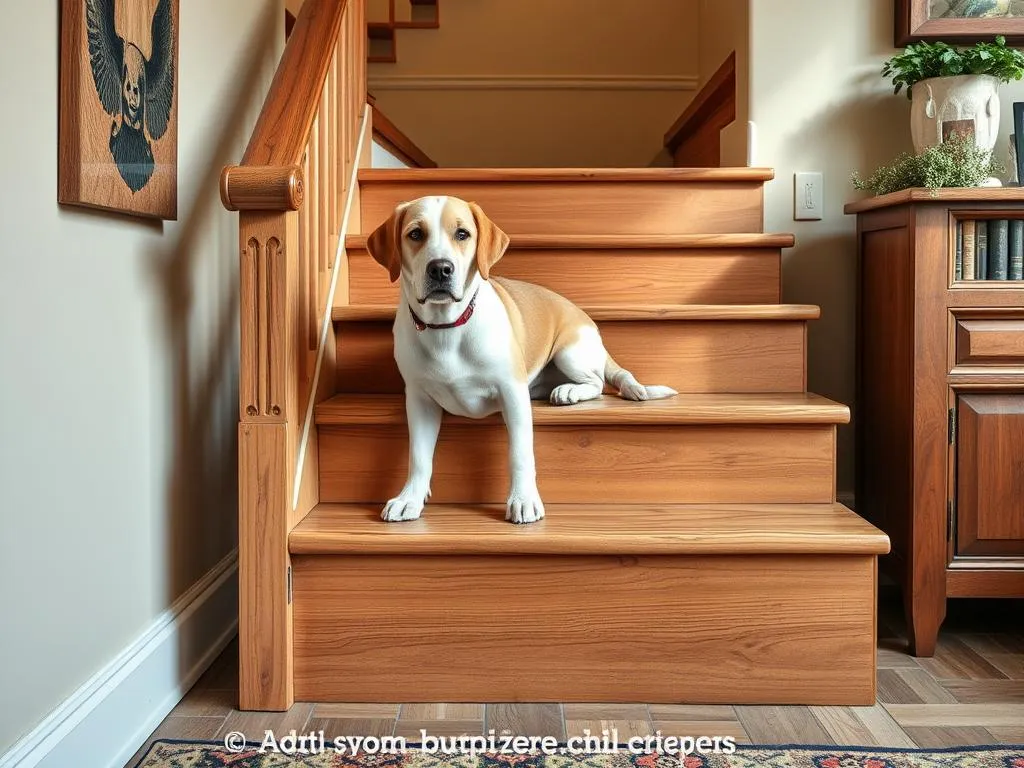
Introduction
Dog stairs are specially designed structures that help our furry friends access elevated areas like beds, couches, and vehicles. The primary purpose of dog stairs is to promote the health and safety of pets, particularly those with mobility issues. As loving pet owners, ensuring that our dogs can navigate their surroundings safely is a top priority.
In addition to the safety aspect, many pet owners are turning to DIY projects as a way to create customized solutions that fit their specific needs. Not only can DIY projects be more cost-effective than purchasing ready-made options, but they also allow for personalization in design and functionality. This article will take you through the journey of understanding, designing, and building your own DIY dog stairs, ensuring both you and your pet benefit from this project.
Understanding the Need for Dog Stairs
Benefits of Dog Stairs
Creating a secure means for dogs to access various heights is crucial for their well-being. Here are some key benefits:
- Safety for Dogs: Dog stairs significantly reduce the risk of injury. Jumping down from high surfaces can lead to sprains, fractures, or worse, especially for dogs that are older or have existing health issues.
- Providing Accessibility for Older or Disabled Dogs: As dogs age, they may struggle with mobility. DIY dog stairs can help them maintain independence and mobility, allowing them to enjoy their favorite spots without assistance.
- Convenience for Owners: Imagine the ease of not having to lift your dog onto the couch or bed. Dog stairs make it simpler for both you and your pet to access elevated areas without any hassle. This convenience works for small breeds struggling with height, as well as larger dogs who may need a little boost now and then.
Types of Dogs That Benefit Most
Certain types of dogs tend to benefit more from dog stairs than others:
- Senior Dogs: Age can bring about various ailments such as arthritis, making climbing difficult. DIY dog stairs can offer them the support they need.
- Dogs with Joint Issues: Breeds prone to joint problems, such as Labradors and Dachshunds, can greatly benefit from the added stability.
- Small Breeds: Smaller breeds often face challenges in reaching higher surfaces. Having their own set of stairs allows them to navigate easily.
- Post-Surgery Recovery: For dogs recovering from surgery, dog stairs can help them maintain mobility while preventing undue strain on their bodies.
Choosing the Right Design for DIY Dog Stairs
Factors to Consider
When embarking on your DIY dog stairs project, there are several factors to keep in mind:
- Height and Width: The stairs must be appropriate for your dog’s size. Measure the height of the surface they need to access and determine the width that will comfortably accommodate their paws.
- Weight Capacity: Ensure that the stairs can support your dog’s weight. This is particularly important for larger breeds or if you have multiple pets.
- Material Options: The material you choose can affect both the durability and the appearance of your stairs. Common materials include wood for sturdiness, plastic for lightweight options, or foam for a softer approach.
Popular Designs
Here are a few popular designs for DIY dog stairs:
- Simple Ramp: A ramp can be an excellent alternative to stairs, particularly for dogs with mobility issues. It allows them to walk up rather than climb.
- Multi-Step Stairs: This is the traditional design and works well for most situations, giving dogs the ability to ascend and descend safely.
- Foldable Options for Space-Saving: If you’re limited on space, consider building foldable stairs that can be stored away when not in use.
Materials and Tools Needed
Essential Materials
To successfully construct your DIY dog stairs, gather the following materials:
- Wood (plywood or solid wood are good choices)
- Screws
- Carpet (for traction)
- Paint or stain (optional for aesthetics)
You can find these materials at local hardware stores or online retailers. Be sure to choose quality materials to ensure the longevity of your stairs.
Tools Required
Here are the basic tools you will need for building:
- Saw: For cutting wood to size.
- Drill: To create holes for screws.
- Measuring Tape: To ensure accurate measurements.
- Screwdriver: For assembling the stairs.
- Sandpaper: To smooth out edges.
Don’t forget about safety equipment! Always wear gloves and goggles to protect yourself while working.
Step-by-Step Guide to Building DIY Dog Stairs
Step 1: Planning and Measurement
Before you begin, it’s essential to determine the size and design of your DIY dog stairs. Measure the height of the surface your dog needs to access and decide how steep you want the stairs to be. A gentle slope is generally easier and safer for dogs.
Step 2: Cutting the Materials
Once you have your measurements, it’s time to cut the wood. Use a saw to make precise cuts according to your plans. Take your time to ensure that all pieces are measured accurately to avoid any discrepancies during assembly.
Step 3: Assembling the Stairs
With your materials cut, it’s time to put everything together. Start by assembling the base and then attach the steps. Use screws to secure each piece. Make sure everything is tightly fastened to ensure stability.
Step 4: Finishing Touches
After assembling your DIY dog stairs, it’s time to sand down any rough edges. This will help prevent splinters and make the stairs safe for your dog. You may also choose to paint or stain the wood to match your home decor.
Step 5: Safety Checks
Before introducing your dog to the new stairs, perform a thorough safety check. Test the stability by applying pressure to different areas. Ensure that the stairs do not wobble or feel unstable.
Tips for Training Your Dog to Use the Stairs
Introducing the Stairs
Once your DIY dog stairs are complete, it’s time to introduce them to your dog. Use treats and encouragement to help your pet feel comfortable with their new stairs. Start by letting them explore the stairs at their own pace.
Ensuring Comfort and Safety
Creating a positive experience is crucial. Use positive reinforcement to reward your dog for using the stairs. Praise them or give them treats when they successfully ascend or descend.
Common Challenges and Solutions
If your dog shows fear or reluctance to use the stairs, don’t force them. Instead, try the following strategies:
- Encouragement: Use their favorite toy or treats to entice them to try the stairs.
- Gradual Exposure: If your dog is particularly fearful, you might start by placing the stairs in a more familiar environment, slowly moving them to the intended location.
- Additional Support: Sometimes, having someone guide them up the stairs can provide the confidence boost they need.
Additional Considerations
Maintenance of DIY Dog Stairs
To keep your DIY dog stairs in good condition, regular maintenance is essential. Clean them frequently to avoid dust and dirt buildup. If you used carpet, consider vacuuming it regularly to keep it fresh.
Customization Ideas
To personalize your DIY dog stairs, consider the following options:
- Color: Choose a paint or stain that complements your home.
- Design: Add non-slip strips or carpet to ensure your dog has traction.
- Additional Features: You can also incorporate storage space or a small drawer for pet supplies under the stairs.
Conclusion
In summary, DIY dog stairs provide a multitude of benefits, from enhancing the safety and mobility of our pets to adding a personalized touch to our homes. Building your own stairs not only saves money but also offers the satisfaction of creating a functional piece that suits your pet’s needs perfectly.
As you embark on this DIY project, remember that the joy and safety of your pet are the most important outcomes. So gather your materials, roll up your sleeves, and enjoy the rewarding process of building a safe space for your beloved dog.
FAQs
-
How tall should dog stairs be?
The height of the stairs should be proportional to the height of the surface your dog is trying to access. Generally, a height of 4 to 6 inches per step is recommended. -
What is the best material for dog stairs?
Wood is often considered the best material due to its durability and strength. However, foam options can be great for portability and softness. -
Can I build stairs for a large dog?
Absolutely! Just ensure that the dimensions and weight capacity of the stairs are sufficient to support your dog’s size and weight.









